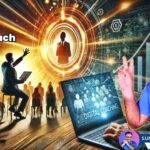In an age where industrialization and urbanization have become synonymous with progress, we often forget about the invisible threat looming over us – air pollution. While it might not always be at the forefront of our minds, its impact on our health and the environment is undeniable. In this blog post, we’ll delve into the issue of air pollution and explore how a simple poster can serve as a powerful tool in raising awareness and inspiring action.

Understanding Air Pollution: Air pollution is the presence of harmful or excessive quantities of substances such as gases (including carbon dioxide, carbon monoxide, sulfur dioxide, and nitrogen oxides), particulates (both organic and inorganic), and biological molecules in the air. These pollutants can come from various sources, including vehicle emissions, industrial activities, agricultural practices, and the burning of fossil fuels.
The Consequences: The consequences of air pollution are far-reaching and multifaceted. From respiratory illnesses such as asthma and bronchitis to cardiovascular diseases and even premature death, the health impacts on humans are severe. Moreover, air pollution also contributes to environmental degradation, including acid rain, ozone depletion, and climate change.
The Power of Visual Communication: In the fight against air pollution, effective communication is key. While scientific reports and articles are essential for understanding the issue, they often fail to capture the attention of the general public. This is where visual communication, such as posters, plays a crucial role. A well-designed poster can convey complex information in a simple and engaging manner, making it accessible to people of all ages and backgrounds.
Creating an Air Pollution Poster: When creating an air pollution poster, there are several key elements to consider:
- Captivating Visuals: Use striking imagery that grabs attention and conveys the seriousness of the issue. Consider using before-and-after photos to illustrate the impact of pollution on the environment.
- Clear Messaging: Keep the message simple and concise. Use bold text to highlight key facts and statistics about air pollution and its effects.
- Call to Action: Inspire viewers to take action by including practical steps they can take to reduce air pollution in their daily lives. This could include using public transportation, conserving energy, and supporting policies that promote clean air.
- Engagement: Encourage interaction by including QR codes or links to additional resources where viewers can learn more about air pollution and how they can get involved in advocacy efforts.
Conclusion: In the battle against air pollution, every action counts. By harnessing the power of visual communication through posters, we can raise awareness, inspire action, and ultimately create a cleaner and healthier environment for generations to come. So let’s roll up our sleeves, pick up our markers, and start spreading the message of clean air for all.
Top 20 FAQs about Breath of Fresh Air
- What is air pollution?
- Air pollution refers to the presence of harmful or excessive quantities of substances in the air, which can pose health risks to humans and damage the environment.
- What are the main sources of air pollution?
- The main sources of air pollution include vehicle emissions, industrial activities, agricultural practices, and the burning of fossil fuels for energy production.
- How does air pollution affect human health?
- Air pollution can lead to a wide range of health problems, including respiratory illnesses such as asthma and bronchitis, cardiovascular diseases, and even premature death.
- What are the environmental impacts of air pollution?
- Air pollution contributes to environmental degradation, including acid rain, ozone depletion, and climate change.
- How can I tell if the air quality in my area is poor?
- You can check the air quality index (AQI) for your area, which provides information about the level of pollution and its potential health effects.
- What are some common indoor air pollutants?
- Common indoor air pollutants include tobacco smoke, household cleaning products, and volatile organic compounds (VOCs) emitted by furniture and building materials.
- How can I reduce air pollution in my daily life?
- You can reduce air pollution by using public transportation, conserving energy, and supporting policies that promote clean air.
- What role do governments play in combating air pollution?
- Governments play a crucial role in implementing regulations and policies to reduce air pollution, such as emissions standards for vehicles and industrial facilities.
- How does air pollution affect children and the elderly?
- Children and the elderly are particularly vulnerable to the health effects of air pollution, as their respiratory and immune systems may be weaker.
- What are some long-term solutions to air pollution?
- Long-term solutions to air pollution include transitioning to renewable energy sources, improving public transportation infrastructure, and promoting sustainable urban planning.
- Can planting trees help reduce air pollution?
- Yes, planting trees can help reduce air pollution by absorbing carbon dioxide and other pollutants from the air.
- What are the health benefits of reducing air pollution?
- Reducing air pollution can lead to significant health benefits, including lower rates of respiratory and cardiovascular diseases, and improved overall quality of life.
- How does air pollution affect wildlife?
- Air pollution can harm wildlife by contaminating water sources, damaging habitats, and reducing food availability.
- What are some short-term actions I can take to improve air quality?
- Short-term actions to improve air quality include carpooling, avoiding idling your vehicle, and using electric or manual lawn and garden tools instead of gasoline-powered ones.
- Are there any natural ways to purify indoor air?
- Yes, some indoor plants can help purify indoor air by absorbing toxins and releasing oxygen.
- What are the economic costs of air pollution?
- The economic costs of air pollution include healthcare expenses, lost productivity, and damage to ecosystems and infrastructure.
- How can I get involved in local efforts to combat air pollution?
- You can get involved in local efforts to combat air pollution by joining advocacy groups, participating in community clean-up events, and contacting elected officials to voice your concerns.
- What are the benefits of promoting renewable energy sources?
- Promoting renewable energy sources such as solar and wind power can reduce air pollution, create jobs, and mitigate climate change.
- What role does technology play in reducing air pollution?
- Technology plays a crucial role in reducing air pollution through innovations such as clean energy technologies, emissions control devices, and air quality monitoring systems.
- How can I raise awareness about air pollution in my community?
- You can raise awareness about air pollution in your community by organizing educational events, sharing information on social media, and collaborating with local schools and organizations.
Related posts:
 Unveiling the Layers of Air Pollution: Primary and Secondary Air Pollutants
Unveiling the Layers of Air Pollution: Primary and Secondary Air Pollutants
 The Deafening Truth: How Traffic Noise Raises the Risk of Cardiovascular Diseases
The Deafening Truth: How Traffic Noise Raises the Risk of Cardiovascular Diseases
 Breathing in Danger: Understanding the Impact of Air Pollution
Breathing in Danger: Understanding the Impact of Air Pollution
 Breathing in the Chaos: Air Pollution Crisis in Delhi
Breathing in the Chaos: Air Pollution Crisis in Delhi
 How to Stay Healthy During High Pollution in Delhi
How to Stay Healthy During High Pollution in Delhi
 When Should You Eat, Before or After Exercise?
When Should You Eat, Before or After Exercise?
 The Silent Threat: Childhood High Blood Pressure Raises Risk of Heart Attack and Stroke
The Silent Threat: Childhood High Blood Pressure Raises Risk of Heart Attack and Stroke
 Nurturing Life: A Journey through Pregnancy
Nurturing Life: A Journey through Pregnancy
 Say No to Tea and Coffee Before and After Meals, Advises Top Medical Body ICMR
Say No to Tea and Coffee Before and After Meals, Advises Top Medical Body ICMR





